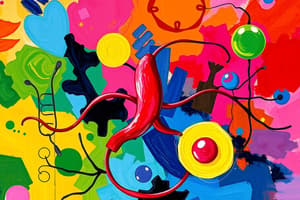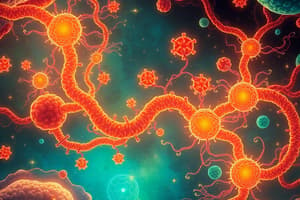Podcast
Questions and Answers
What is the main function of glycolysis in cellular respiration?
What is the main function of glycolysis in cellular respiration?
- To convert glucose into pyruvate while producing ATP (correct)
- To break down fatty acids into carbohydrates
- To synthesize DNA from glucose
- To convert NADH back to NAD+ directly
How many ATP molecules are produced during glycolysis?
How many ATP molecules are produced during glycolysis?
- 3 ATP
- 1 ATP
- 4 ATP
- 2 ATP (correct)
What happens to pyruvate after glycolysis?
What happens to pyruvate after glycolysis?
- It is converted to glucose in the cytoplasm
- It enters the mitochondrial matrix and is turned into Acetyl CoA (correct)
- It is immediately used to produce ethanol
- It is converted into lactate if oxygen is present
Which of the following statements about NAD+ in glycolysis is true?
Which of the following statements about NAD+ in glycolysis is true?
What metabolic issue might arise from McArdle disease?
What metabolic issue might arise from McArdle disease?
What is the primary role of oxygen in the process described?
What is the primary role of oxygen in the process described?
How many ATP are typically produced from one molecule of NADH?
How many ATP are typically produced from one molecule of NADH?
How is FADH2 converted back into FAD?
How is FADH2 converted back into FAD?
What happens to high-energy electrons as they move through the electron transport chain?
What happens to high-energy electrons as they move through the electron transport chain?
What is the result of the process known as oxidative phosphorylation?
What is the result of the process known as oxidative phosphorylation?
Which statement about ATP production from FAD is correct?
Which statement about ATP production from FAD is correct?
During what stage are electrons transferred through various carriers?
During what stage are electrons transferred through various carriers?
What role does the intermembrane space play in oxidative phosphorylation?
What role does the intermembrane space play in oxidative phosphorylation?
What is produced as a byproduct during the conversion of pyruvate to Acetyl CoA?
What is produced as a byproduct during the conversion of pyruvate to Acetyl CoA?
How many NADH are generated at the end of the pyruvate decarboxylation process?
How many NADH are generated at the end of the pyruvate decarboxylation process?
During the Citric Acid Cycle, how many carbon atoms are lost from the citrate molecule?
During the Citric Acid Cycle, how many carbon atoms are lost from the citrate molecule?
What is the fate of the electrons extracted from NADH and FADH2 during oxidative phosphorylation?
What is the fate of the electrons extracted from NADH and FADH2 during oxidative phosphorylation?
What is the primary purpose of the Citric Acid Cycle?
What is the primary purpose of the Citric Acid Cycle?
Which molecule is formed when Acetyl CoA combines with oxaloacetate?
Which molecule is formed when Acetyl CoA combines with oxaloacetate?
What occurs at the end of the Citric Acid Cycle regarding ATP production?
What occurs at the end of the Citric Acid Cycle regarding ATP production?
Which component is primarily responsible for generating ATP in the electron transport chain?
Which component is primarily responsible for generating ATP in the electron transport chain?
In which part of the cell does the Citric Acid Cycle take place?
In which part of the cell does the Citric Acid Cycle take place?
What is the main electron carrier molecule for the electron transport chain?
What is the main electron carrier molecule for the electron transport chain?
Which enzyme plays a key role in the first step of glycolysis?
Which enzyme plays a key role in the first step of glycolysis?
What is a major output from one complete turn of the Citric Acid Cycle?
What is a major output from one complete turn of the Citric Acid Cycle?
Which process is NOT involved in the aerobic metabolism of glucose?
Which process is NOT involved in the aerobic metabolism of glucose?
What is the final electron acceptor in the electron transport chain?
What is the final electron acceptor in the electron transport chain?
Which of the following processes directly converts ADP into ATP during glycolysis?
Which of the following processes directly converts ADP into ATP during glycolysis?
What is the role of NAD+ in the glycolysis process?
What is the role of NAD+ in the glycolysis process?
How does McArdle disease primarily affect glycolysis?
How does McArdle disease primarily affect glycolysis?
What is the primary product of pyruvate decarboxylation?
What is the primary product of pyruvate decarboxylation?
What is the number of reactions involved in glycolysis?
What is the number of reactions involved in glycolysis?
During glycolysis, which of the following is NOT a product formed?
During glycolysis, which of the following is NOT a product formed?
Which molecule enters the mitochondrial matrix for decarboxylation?
Which molecule enters the mitochondrial matrix for decarboxylation?
Which of the following statements about glycolysis is accurate?
Which of the following statements about glycolysis is accurate?
Which of the following is an intermediate product during glycolysis?
Which of the following is an intermediate product during glycolysis?
What is the fate of the carbon atoms from glucose after glycolysis?
What is the fate of the carbon atoms from glucose after glycolysis?
What is the average ATP yield from one FADH2 molecule during oxidative phosphorylation?
What is the average ATP yield from one FADH2 molecule during oxidative phosphorylation?
Which of the following statements accurately describes the role of NADH in the electron transport chain?
Which of the following statements accurately describes the role of NADH in the electron transport chain?
How do high-energy electrons behave as they move through the electron transport chain?
How do high-energy electrons behave as they move through the electron transport chain?
What primary event occurs as a result of oxidative phosphorylation?
What primary event occurs as a result of oxidative phosphorylation?
Which of the following statements about the electron transport chain is correct?
Which of the following statements about the electron transport chain is correct?
What is the function of the intermembrane space during oxidative phosphorylation?
What is the function of the intermembrane space during oxidative phosphorylation?
What is generated when NADH and FADH2 are converted back to their oxidized forms?
What is generated when NADH and FADH2 are converted back to their oxidized forms?
What is the primary role of oxygen in the processes described?
What is the primary role of oxygen in the processes described?
Which byproduct is formed as a result of the electron transfer process in the electron transport chain?
Which byproduct is formed as a result of the electron transfer process in the electron transport chain?
What is produced as a result of the conversion of pyruvate to Acetyl CoA?
What is produced as a result of the conversion of pyruvate to Acetyl CoA?
In the Citric Acid Cycle, what is the starting molecule that combines with Acetyl CoA?
In the Citric Acid Cycle, what is the starting molecule that combines with Acetyl CoA?
How many NADH molecules are produced during one complete cycle of the Citric Acid Cycle?
How many NADH molecules are produced during one complete cycle of the Citric Acid Cycle?
During oxidative phosphorylation, what is the primary role of the electrons extracted from NADH and FADH2?
During oxidative phosphorylation, what is the primary role of the electrons extracted from NADH and FADH2?
What byproduct is produced alongside the loss of carbon during the Citric Acid Cycle?
What byproduct is produced alongside the loss of carbon during the Citric Acid Cycle?
What is the final molecule produced at the end of the oxidative phosphorylation process?
What is the final molecule produced at the end of the oxidative phosphorylation process?
Which of the following statements correctly describes the fate of Acetyl CoA in the mitochondrial matrix?
Which of the following statements correctly describes the fate of Acetyl CoA in the mitochondrial matrix?
During the Citric Acid Cycle, how many ATP molecules are generated from one complete cycle?
During the Citric Acid Cycle, how many ATP molecules are generated from one complete cycle?
Which component ultimately acts as the final electron acceptor in the electron transport chain?
Which component ultimately acts as the final electron acceptor in the electron transport chain?
What is the primary function of CoA in the energy metabolism described?
What is the primary function of CoA in the energy metabolism described?
Flashcards are hidden until you start studying
Study Notes
Cellular Respiration Overview
- Cellular metabolism primarily involves respiration, which can be divided into several key stages: glycolysis, pyruvate decarboxylation, citric acid cycle, and oxidative phosphorylation.
Glycolysis
- Involves 10 sequential reactions breaking down 1 glucose (6 carbon) into 2 pyruvate (3 carbon).
- Directly generates 2 ATP and 2 NADH from the breakdown of glucose.
- Essential for energy production; plays a role in various metabolic diseases, such as McArdle disease, which affects glycogen conversion.
Pyruvate Decarboxylation
- Pyruvate enters the mitochondrial matrix, converting into Acetyl CoA (2 carbon molecule).
- This process releases 1 CO2 and produces 1 NADH for each pyruvate.
- Requires oxygen to proceed and marks the transition from glycolysis to the citric acid cycle.
Citric Acid Cycle (Tricarboxylic Acid Cycle)
- Comprises 8 enzyme-directed reactions occurring in the mitochondrial matrix.
- Starts with the combination of oxaloacetate and Acetyl CoA to form citrate.
- During the cycle, 2 carbons are lost as CO2, resulting in the production of 6 NADH and 2 FADH2.
- Generates only 2 ATP per cycle.
Oxidative Phosphorylation: Electron Transport Chain (ETC)
- High-energy electrons are extracted from NADH and FADH2, stored in hydrogen atoms.
- Located on the inner mitochondrial membrane, the ETC comprises a series of electron carrier molecules.
- Most ATP is produced during this stage, with 1 NADH generating approximately 2.5 ATP and 1 FAD yielding around 1.5 ATP.
- Oxygen serves as the final electron acceptor, facilitating ATP synthesis through oxidative phosphorylation.
Summary of Energy Production
- Glycolysis, the citric acid cycle, and oxidative phosphorylation collectively contribute to cellular energy production.
- The entire respiration process ensures efficient conversion of energy stored in glucose into usable ATP while releasing byproducts like CO2.
Cellular Respiration Overview
- Cellular metabolism primarily involves respiration, which can be divided into several key stages: glycolysis, pyruvate decarboxylation, citric acid cycle, and oxidative phosphorylation.
Glycolysis
- Involves 10 sequential reactions breaking down 1 glucose (6 carbon) into 2 pyruvate (3 carbon).
- Directly generates 2 ATP and 2 NADH from the breakdown of glucose.
- Essential for energy production; plays a role in various metabolic diseases, such as McArdle disease, which affects glycogen conversion.
Pyruvate Decarboxylation
- Pyruvate enters the mitochondrial matrix, converting into Acetyl CoA (2 carbon molecule).
- This process releases 1 CO2 and produces 1 NADH for each pyruvate.
- Requires oxygen to proceed and marks the transition from glycolysis to the citric acid cycle.
Citric Acid Cycle (Tricarboxylic Acid Cycle)
- Comprises 8 enzyme-directed reactions occurring in the mitochondrial matrix.
- Starts with the combination of oxaloacetate and Acetyl CoA to form citrate.
- During the cycle, 2 carbons are lost as CO2, resulting in the production of 6 NADH and 2 FADH2.
- Generates only 2 ATP per cycle.
Oxidative Phosphorylation: Electron Transport Chain (ETC)
- High-energy electrons are extracted from NADH and FADH2, stored in hydrogen atoms.
- Located on the inner mitochondrial membrane, the ETC comprises a series of electron carrier molecules.
- Most ATP is produced during this stage, with 1 NADH generating approximately 2.5 ATP and 1 FAD yielding around 1.5 ATP.
- Oxygen serves as the final electron acceptor, facilitating ATP synthesis through oxidative phosphorylation.
Summary of Energy Production
- Glycolysis, the citric acid cycle, and oxidative phosphorylation collectively contribute to cellular energy production.
- The entire respiration process ensures efficient conversion of energy stored in glucose into usable ATP while releasing byproducts like CO2.
Studying That Suits You
Use AI to generate personalized quizzes and flashcards to suit your learning preferences.





